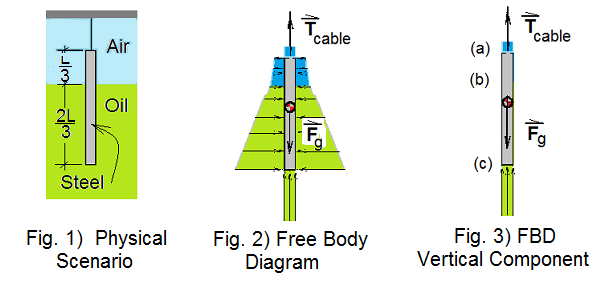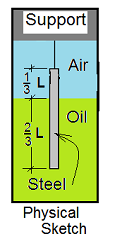| THERMO Spoken Here! ~ J. Pohl © | TOC NEXT ~ 74 |
Air, Oil, Cable Support a Rod
A cylindrical steel rod of length "L" and a cross-sectional area, "A" is suspended by a cable. The upper third of the bar is surrounded by atmospheric air; the lower two-thirds of the rod is submerged in oil. Determine an equation for the tension of the cable?
Three sketches used for the solution are shown and discussed below.

The sketch, Fig-1, shows the "physical scenario" or the physical arrangement. The physical scenario shows all possible choices of system and surroundings. It includes material germaine to the event, material in the vacinity and all of the universe. No "system" has been selected. Fig-1 is insufficient for our calculation.
Calculations of force require the physical principle; Newton's Second Law. The law applies to an event of a finite amount of matter; in our case the event is equilibrium and the matter is the steel rod. We write the Second Law for the steel rod as system.
Eqn-1 is subscripted, "steel rod." Its superscript, "0XZ," states our assumed inertial coordinate system of the event: the "0XZ" plane. The event, of course, is called "permanence;" no change occurs. Velocities and forces are vectors.
 |
(1) |
To be applied to physical reality, Newton's 2nd Law needs a special perspective of the system matter. The task of drawing this perspective is called "isolation." The result is the system separated from its surroundings with all relevant forces notated. Fig-2 shows the free-body-diagram (isolated view) of our system (the steel rod). The forces involved are the tension of the cable, the gravity force and pressure forces of contact with the surrounding air above and water below. Again, see Fig-2.
To continue, two changes are applied to Eqn-1. We observe that the velocity of the rod equals zero for all times. (We know that because the rod does not move. No motion means zero velocity). Thus Eqn-1 reduces to Eqn-2 below. Next, our concern with forces is in the vertical (K) direction only (forces action horizontally are symmetris and add to zero. Apply the vector dot-product to Eqn-2 to have Eqn-3.
 |
(2) |  |
(3) |
The next step is to expand Eqn-3, to itemize the relevant forces. Eqn-4 identifies those forces implicitly:
 |
(4) |
The forces of Eqn-4 are written "implicitly." To proceed these must be stated "explicitly." The list below explains some "parts" of Eqn-4.
- First in the list is the cable tension we seek, "T." That force acts upward; its sign is "+".
- The next force on the steel rod is that of the fluid contact of air acting across its top. This force (equaling the ambient pressure times the area of its action) acts downward, its sign is " - ".
- Gravity acts downward on the steel bar: " - ".
- A force acts on the bottom of the bar. There is fluid contact there. Some say, the oil pushes upward on the bar: the sign is " + ."
When expressions for pressure and gravity force are appl;ie, Eqn-4 is changed to Eqn-5.
 |
(5) |
To express Eqn-5 more directly, we write the pressures. A first step is to locate a place where the pressure is known. We assume the pressure of the atmospheric pressure at the air/oil interface to be one atmosphere and that the densities of air and oil are constant over their heights. The pressure acting over the top of the bar is slightly less than atmospheric, Eqn-6. The pressure acting over the bottom of the bar is greater that atmospheric, Eqn-7.
 |
(6) |  |
(7) |
The density of air, ρair,avg is the average density between the surface and height "L," the top of the bar.
The density of air, ρair,avg is the average density between the surface and height "L," the top of the bar. This number is essentially equal to the ambient density of air. This is also true of the oil.
Placing the results (6) and (7) in in Eqn-4 we obtain:
 |
(8) |
We see that patm, the prevailing atmospheric pressure "removes" itself from the equation. This means the answers are okay "sunshine or storm" for the weather.
Equation (8) is our resulting Second Law of motion for the steel bar. Eqn-8 has not been "algebraically messed up." Each term is a force. We notice that atmospheric pressure sum to zero; our answer will be the same irrerspective of the weather, irrespective of other values of atmospheric pressure.
As a very last step, we rearrange Eqn-8 to place "T left of equality. Double check the algebra, please.
 |
(9) |
Granted, the density of air is small but just leave it in the equation. No harm.
Thus although the density of air is small, we see that an increase of that density will result in a increase of the force required of the cable, T. Does this make sense? Check it out!
Oil, Cable Support a Rod

A cylindrical steel bar of length "L" and a cross-sectional area, "A" is suspended by a cable. The upper third of the bar is surrounded by atmospheric air; the lower two-thirds of the bar is submerged in oil. Determine an equation for the tension of the cable?
Premise presently unwritted!